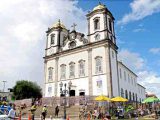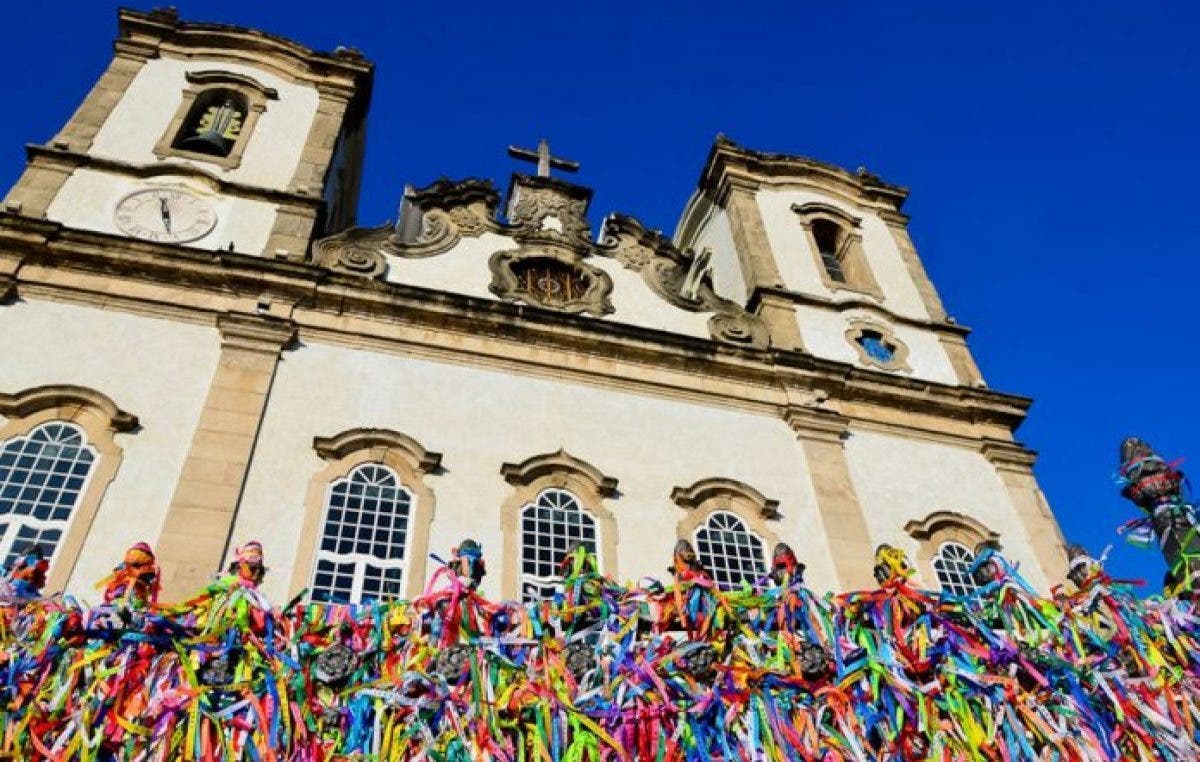Este post também está disponível em:
Português
English

The Church of Nosso Senhor do Bonfim is not the prettiest, but it is certainly the most famous in Salvador because of the traditional “Lavagem do Bonfim”, a celebration marked by Bahian women throwing water on the steps of the church in an all-day party, animated by afoxé groups.
Dorival Caymmi sang, in one of his songs “A igreja Senhor do Bonfim”, that Salvador has 365 churches, so that Bahians celebrate their faith in a different corner every day of the year.
Nobody knows for sure if this is really the number of Catholic temples in the Bahian capital and some say there are even more.
One thing is certain: the Catholic churches built here since the city’s foundation hold stories as well as relics. They take visitors back to a past where faith and art were together on the same altar.
Salvador’s churches have a variety of styles, ranging from baroque to neoclassical.
They were built with the most diverse materials, from lioz stone to gold. Some still have oil-painted panels and ceilings, tiles from Portugal and sacred images that are works of art.
Details that make Salvador’s temples much more than houses of prayer, they are monuments of inestimable artistic value.
Video about the Church of Church of Nosso Senhor do Bonfim

História da Igreja de Nosso Senhor do Bonfim
Pelourinho’s architectural relics
In the architectural ensemble of Pelourinho, the churches stand out for their quantity, variety and beauty.
The buildings of the religious orders and the sobrados began to surround Terreiro de Jesus in the 18th century.
It is precisely in the Historic Center that some of Salvador’s most important temples are located, such as the Catedral Basílica (former Jesuit church), built in the 17th century in the Baroque and Rococo styles.
In the same XV de Novembro square, known as Terreiro de Jesus, four other churches are distributed among the old houses and the fountain of French origin from 1855.
The Basilica Cathedral, the Church of the Third Order of São Francisco, the Church of São Pedro dos Clérigos, the Church of the Third Order of São Domingos and the Church and Convent of São Francisco.
See also Churches of Salvador da Bahia
The Church of the Third Order of St. Francis dates from 1702. It has a façade in chiseled carved stone, reminiscent of the Spanish Baroque, and is the only example in Brazil to feature saints, figures, angels, faces, emblems, crowns, branches, among other ornaments.
For some time, this façade was covered with mortar and it was only at the beginning of the 20th century, during the laying of the electricity grid in the area, that its original design was re-discovered. It is by Gabriel Ribeiro, considered one of the introducers of the Baroque style in Bahia.
On the ceiling there are paintings created in 1831 by Franco Velasco. The annex houses a museum that reproduces a noble hall, with a collection of sacred works, priestly vestments and a meeting room with Portuguese tiles. Opening hours are Monday to Friday, from 8am to 11.30am and 1pm to 5pm.
The Basilica Cathedral dates back to the early 17th century and occupies the fourth building constructed on the site.
The temple, which has materials such as gold, marble, jacaranda wood and tortoiseshell ivory, has internal and external stone cladding, and has two towers and wooden vaults.
The niches above the church doors on the façade feature images of three Jesuit saints – St. Ignatius of Loyola, St. Francis Xavier (patron saint of Salvador) and St. Francis of Borja.
Inside, the carvings on the altars tell the story of the evolution of architectural styles in Bahia.
The church mixes Baroque and Rococo styles. Of particular note are the altars of the Holy Martyrs and the Virgin Martyrs from the original Church of the Jesuit College, both dating from the 16th century.
It was in one of the Cathedral’s cells that Father Antônio Vieira died on July 18, 1697, after being condemned by the Inquisition for his sermons. Other tombstones include that of the third Governor-General of Brazil, Mem de Sá.
The building also houses the Cathedral Museum, with a collection of gold and silver pieces from the 16th to the 20th centuries. It hosts concerts by the Barroco na Bahia group and the Bahia Symphony Orchestra.
Opening hours are Monday to Saturday, from 8am to 11.30am and from 2pm to 5.30pm. Masses take place from Tuesday to Friday, always at 6pm.
The Church and Convent of São Francisco is one of the richest in Brazil and is considered the most beautiful example of Portuguese Baroque in the world. The interior of the temple is covered in gold and rosewood.
The Baroque is present on the façade and in the panels of Portuguese tiles, which reproduce the birth of Saint Francis and his renunciation of material goods.
It is also in the interior, made up of wood carvings and decorated with all the symbols of the Baroque style: acanthus leaves, pelica-nos, flowers, angels, mermaids, among others.
The convent began to be built a century after the first Franciscans arrived in Salvador in 1587. Work on the church only began in the first half of the 18th century.
It is said that a thousand kilos of gold powder were used just to shape the carving.
The ceiling paintings are in the shape of stars, hexagons and octagons. In the sacristy, there are 18 oil panels on the life of St. Francis.
Sculptures by the great Bahian saint-maker Manuel Inácio da Costa can also be seen in the Church of St. Francis.
History of the construction of the Church of Nosso Senhor do Bonfim
The construction of this pilgrimage shrine began in 1740 by Teodório Rodrigues de Faria, a captain in the Portuguese Navy.
Situated on the only hill on the Itapagipe peninsula, the Bonfim Church was practically completed in 1754, and the Brotherhood was founded the following year.
The square in front of it is bordered on two sides by groups of houses for pilgrims, built by the Brotherhood in the 19th century.
The plan of the church is of the type common in the early 18th century, with a nave and choir flanked by aisles and superimposed tribunes, with a chancel flanked by a sacristy and a room for ex-votos.
Made of stone and brick, the building has arcaded porticoes along the nave, a transition between the 17th century avarandados and the 18th century side aisles.
Its façade, practically covered in white Portuguese tiles from 1873, has two bulbous towers from the end of the last century, when changes were made to the frontispiece.
The interior is decorated in neoclassical style, with the nave ceiling painting by Franco Velasco from 1818 standing out. It is the seat of one of Bahia’s most traditional devotions;
History of the Bonfim Festival
The Bonfim Festival is a reference in the affirmation of Bahian culture.
According to Iphan, the Bonfim festival has been held since 1745 without interruption, uniting Catholicism with Afro-Brazilian tradition. Historians point out that the festivities began in the Middle Ages, with devotion to Senhor Bom Jesus, the Crucified Christ.
The celebration is part of the liturgical calendar and of the Bahian capital’s square festivals, which are mixed with profane and cultural activities. It begins the day after Santos Reis and ends on the second Sunday after Epiphany, which is Senhor do Bonfim Day.
The end of the procession, which begins at the Church of Conceição da Praia in Comércio, takes place at the Church of Senhor do Bonfim itself, where the washing of the steps takes place on the Sacred Hill. The basilica was built in the 18th century and has been listed by Iphan since 1938 in the Book of Fine Arts.
Churches in Salvador’s Lower Town
Two churches are the best known of the dozens that have been built in the lower city.
The Igreja Nossa Senhora da Conceição da Praia and the Igreja de Nosso Senhor do Bonfim, the latter the most famous in Salvador, are also the stage for two major popular festivals in honor of Catholic saints.
In the lower city there are also the churches of Boa Viagem, Monte Serrat, Nossa Senhora da Penha, Nossa Senhora dos Mares, Nossa Senhora do Pilar and São Joaquim, among others.
The image of Nossa Senhora da Conceição da Praia was brought by Governor Tomé de Souza, meaning that the history of devotion to the saint coincides with the history of Salvador.
The governor ordered a first chapel to be built for the saint, and it wasn’t until 1739 that a church began to be erected using Portuguese stonework, which took a long time to arrive in Brazil.
In 1820, the grandson of the first master builder finally completed the work.
The church of Nossa Senhora da Conceição da Praia, which was elevated to the category of basilica in 1946, has a perspective ceiling by José Joaquim da Rocha, founder of the Bahian School of Painting and the main Brazilian sacred painter.
Since the 18th century, the city of Salvador has been blessed by Our Lord of Bonfim from the top of the Sacred Hill. It is a sacred place for the people, and receives the faithful every day to ask for graces and pay promises.
The proof of such faith can be seen in the museum of ex-votos, where devotees leave a wax object in thanks for the graces received from Bahia’s most popular saint.
The cult began when Teodósio Rodrigues de Faria, an officer in the Portuguese Navy, brought an image of Christ from Lisbon and took it to the church of Penha in Itapagipe in 1745.
Almost ten years later, in July 1754, the image was given its own church and arrived at the top of the Sacred Hill followed by a procession. The saint became popularized as the one who cures illnesses and saves lives.
The rococo façade of the Church of Our Lord of Bonfim is covered in white Portuguese tiles, which arrived at the church a hundred years after it was built.
The interior of the Church of Our Lord of Bonfim is neoclassical, with paintings of men and clouds on the ceiling, done between 1818 and 1820 by Franco Velasco.
In the sacristy, the church also houses a beautiful collection of paintings by José Tehófilo, one of Bahia’s painters of the late 18th century.
Another way to please the saint is the famous Lavagem do Bonfim festival, which takes place in January on the second Thursday after Three Kings’ Day.
The steps and churchyard are washed with scented water, and the population asks for protection and revels in the profane festival that brings together thousands of Bahians and tourists.
The festivities begin with a procession of Bahian women from the Church of Nossa Senhora da Conceição da Praia, which makes its way to the top of Bonfim, with no end in sight.
Salvador has 365 Catholic churches, countless Evangelical and Protestant temples, and countless Candomblé and other African religions. How do Salvadorans live in harmony with all this? The formula is respect, learned from the roots or already in the blood!
Bahia.ws is the largest travel and tourism guide for Bahia and Salvador.



















